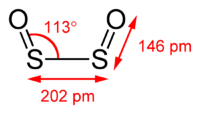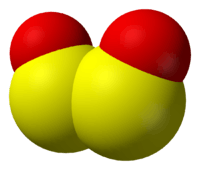Disulfur dioxide
| Disulfur dioxide | ||
|---|---|---|
 | ||
 | ||
| Other names disulfur(II)oxide | ||
| Identifiers | ||
| CAS number | 126885-21-0 [1] | |
| Jmol-3D images | {{#if:O=[S][S]=O|Image 1 | |
| ||
| ||
| Properties | ||
| Molecular formula | S2O2 | |
| Molar mass | 96.1299 g/mol | |
| Appearance | gas | |
| Structure | ||
| Coordination geometry |
bent | |
| Hazards | ||
| Main hazards | toxic | |
| Related compounds | ||
| Related compounds | tetrasulfur SO, S3O S2O | |
| Except where noted otherwise, data are given for materials in their standard state (at 25 °C (77 °F), 100 kPa) | ||
| Infobox references | ||
Disulfur dioxide, dimeric sulfur monoxide or SO dimer is an oxide of sulfur.[2] The molecule is unstable with a lifetime of a few seconds.[3] It is an asymmetric top molecule.[1] The molecule adopts cis-planar structure with C2v symmetry with the two sulfur atoms joined.[4] The shape is the same as the tetrasulfur molecule S4.[4] The S-O bond length is 145.8 pm, shorter than in the monomer, and the S-S bond length is 202.45 pm. The OSS angle is 112.7°. S2O2 has a dipole moment of 3.17 D.[5]
Formation
Sulfur monoxide (SO) converts to disulfur dioxide (S2O2) spontaneously and reversibly.[5] So the substance can be generated by methods that produce sulfur monoxide. Disulfur dioxide has also been formed by an electric discharge in sulfur dioxide.[4] Another laboratory procedure is to react oxygen atoms with carbon oxysulfide or carbon disulfide vapour.[6]
Although elemental sulfur and sulfur dioxide do not combine, the exotic species atomic sulfur is extremely reactive and combines spontaneously with sulfur dioxide to form sulfur monoxide, the intermediate molecule formed is disulfur dioxide:[7]
- S + SO2 → S2O2
- S2O2 ⇌ 2SO
Disulfur dioxide is also produced upon a microwave discharge in sulfur dioxide diluted in helium.[8] At a pressure of 0.1 mm Hg,five percent of the result is S2O2.[9]
Disulfur dioxide is formed transiently when hydrogen sulfide and oxygen undergo flash photolysis.[10]
At one time burning sulfur was thought to make the molecule based on the ultraviolet spectrum.[11]
Properties
The ionisation energy of disulfur dioxide is 9.93±0.02 eV.[6]
Reactions
Although disulfur dioxide exists in equilibrium with sulfur monoxide, it also reacts with sulfur monoxide to form sulfur dioxide and disulfur monoxide.[8][12]
Complexes
S2O2 can be a ligand with transition metals. It binds in the η2-S,S' position with both sulfur atoms linked to the metal atom.[13] This was first shown in 2003. The bis-(trimethylphosphine) thiirane S-oxide complex of platinum, when heated in toluene at 110°C loses ethylene, and forms a complex with S2O2: (Ph3P)2PtS2O2.[14] Iridium atoms can also form a complex: cis-[(dppe)2IrS2]Cl with sodium periodate oxidises to [(dppe)2IrS2O] and then to [(dppe)2IrS2O2], with dppe being 1,2-Bis(diphenylphosphino)ethane.[15][16] This substance has the S2O2 in a cis position. The same conditions can make a trans complex, but this contains two separate SO radicals instead. The iridium complex can be decomposed with triphenyl phosphine to form triphenyl phosphine oxide, and triphenyl phosphine sulfide.[15]
A S2O2 macrocycle has nothing to do with this molecule, this is a larger organic ring molecule with sulfur and oxygen atoms positioned to be ligands for a metal ion, for example 5,8-dioxa-2,11-dithia-[12]-o-cyclophane.[17]
Anion
The S2O2- anion has been made in the gas phase, and may in fact have the trigonal shape with a sulfur atom attached to two oxygens and one other sulfur atom.[18]
Spectrum
Microwave
| Transition | Frequency MHz[4] |
|---|---|
| 21,1−20,2 | 11013.840 |
| 41,3−40,4 | 14081.640 |
| 11,1−00,0 | 15717.946 |
| 40,4−31,3 | 16714.167 |
| 31,3−20,2 | 26342.817 |
| 42,2−41,3 | 26553.915 |
| 22,0−21,1 | 28493.046 |
| 60,6−51,5 | 30629.283 |
| 52,4−51,5 | 35295.199 |
| 51,5−40,4 | 35794.527 |
References
- ↑ 1.0 1.1 Demaison, Jean; Vogt, Jürgen (2011). "836 O2S2 Disulfur dioxide". Asymmetric Top Molecules, Part 3. Landolt-Börnstein - Group II Molecules and Radicals 29D3. Springer. p. 492. doi:10.1007/978-3-642-14145-4_258. ISBN 978-3-642-14145-4.
- ↑ Arnold F. Holleman, Egon Wiber, Nils Wiberg, ed. (2001). "Oxides of sulfur". Inorganic Chemistry. Academic Press. p. 530.
- ↑ Mitchell, Stephen C. (09/03/2004). Biological Interactions Of Sulfur Compounds. CRC Press. p. 7. ISBN 0203362527.
- ↑ 4.0 4.1 4.2 4.3 Thorwirth, Sven; P. Theulé, C. A. Gottlieb , H. S. P. Müller, M. C. McCarthy, P. Thaddeus (23 February 2006). "Rotational spectroscopy of S2O: vibrational satellites, 33 S isotopomers, and the submillimeter-wave spectrum". Journal of Molecular Structure 795: 219–229.
- ↑ 5.0 5.1 Spectroscopic studies of the SO2 discharge system. II. Microwave spectrum of the SO dimer Lovas F. J., Tiemann E., Johnson D.R. The Journal of Chemical Physics (1974), 60, 12, 5005-5010 doi:10.1063/1.1681015
- ↑ 6.0 6.1 Cheng, Bing-Ming; Wen-Ching Hung (1999). "Photoionization efficiency spectrum and ionization energy of S[sub 2]O[sub 2]". The Journal of Chemical Physics 110 (1): 188. doi:10.1063/1.478094. ISSN 0021-9606.
- ↑ Murakami, Yoshinori; Shouichi Onishi, Takaomi Kobayashi, Nobuyuki Fujii, Nobuyasu Isshiki, Kentaro Tsuchiya, Atsumu Tezaki, Hiroyuki Matsui (2003). "High Temperature Reaction of S + SO2→ SO + SO: Implication of S2O2Intermediate Complex Formation". The Journal of Physical Chemistry A 107 (50): 10996–11000. doi:10.1021/jp030471i. ISSN 1089-5639.
- ↑ 8.0 8.1 Field, T A; A E Slattery, D J Adams, D D Morrison (2005). "Experimental observation of dissociative electron attachment to S2O and S2O2 with a new spectrometer for unstable molecules". Journal of Physics B: Atomic, Molecular and Optical Physics 38 (3): 255–264. doi:10.1088/0953-4075/38/3/009. ISSN 0953-4075.
- ↑ Pujapanda, Balaram Sahoo, Nimain C. Nayak, Asutosh Samantaray, Prafulla K.; Balaram, Sahoo; Charan, nayak Nimai; samantaray Asutosh, pujapanda Prafulla Kumar. Inorganic Chemistry. PHI Learning Pvt. Ltd. p. 461. ISBN 9788120343085. Retrieved 16 May 2013.
- ↑ Compton, R. G.; Bamford, C.H.; Tipper, C.F.H. (1972). "Oxidation of H2S". Reactions of Non-Metallic Inorganic Compounds. Comprehensive Chemical Kinetics. Elsevier. p. 50. ISBN 0080868010.
- ↑ Murthy, A. R. Vasudeva (1952). "Studies in the chemical behaviour of some compounds of sulphur - Springer". Retrieved 16 May 2013.
- ↑ Herron, J. T.; R. E. Huie (1980). "Rate constants at 298 K for the reactions sulfur monoxide + sulfur monoxide + M -> dimeric sulfur monoxi de + M and sulfur monoxide + dimeric sulfur monoxide -> sulfur dioxide + sulfur oxide (S2O).". Chemical Physics Letters 76 (2): 322–324.
- ↑ Halcrow, Malcolm A.; John C. Huffman, George Christou (1994). "Synthesis, Characterization, and Molecular Structure of the New S2O Complex Mo(S2O)(S2CNEt2)3.cntdot.1/2Et2O". Inorganic Chemistry 33 (17): 3639–3644. doi:10.1021/ic00095a005. ISSN 0020-1669.
- ↑ Lorenz, Ingo-Peter; Jürgen Kull (1986). "Complex Stabilization of Disulfur Dioxide in the Fragmentation of ThiiraneS-Oxide on Bis(triphenylphosphane)platinum(0)". Angewandte Chemie International Edition in English 25 (3): 261–262. doi:10.1002/anie.198602611. ISSN 0570-0833.
- ↑ 15.0 15.1 Schmid, Günter; Günter Ritter, Tony Debaerdemaeker (1975). "Die Komplexchemie niederer Schwefeloxide, II. Schwefelmonoxid und Dischwefeldioxid als Komplexliganden". Chemische Berichte 108 (9): 3008–3013. doi:10.1002/cber.19751080921. ISSN 0009-2940.
- ↑ Nagata, K; N. Takeda, N Tokitoh N (2003). "Unusual Oxidation of Dichalcogenido Complexes of Platinum". Chemical Letters 32 (2): 170–171. ISSN 0366-7022.
- ↑ Yoon, Il; Ki-Min Park, Jong Hwa Jung, Jineun Kim, Sung Bae Park, Shim Sung Lee (Feb 2002). "Synthesis and Crystal Structures of S2O2 Macrocycle L, and its Silver(I) and Platinum(II) Complexes (Where L = 5,8-dioxa-2,11-dithia-[12]-o-cyclophane)". Journal of Inclusion Phenomena and Macrocyclic Chemistry 42 (1/2): 45–50. doi:10.1023/A:1014558814416. ISSN 0923-0750.
- ↑ Clements, Todd G.; Hans-Jürgen Deyerl, Robert E. Continetti (2002). "Dissociative Photodetachment Dynamics of S2O2-". The Journal of Physical Chemistry A 106 (2): 279–284. doi:10.1021/jp013329v. ISSN 1089-5639. Retrieved 2013-05-13.